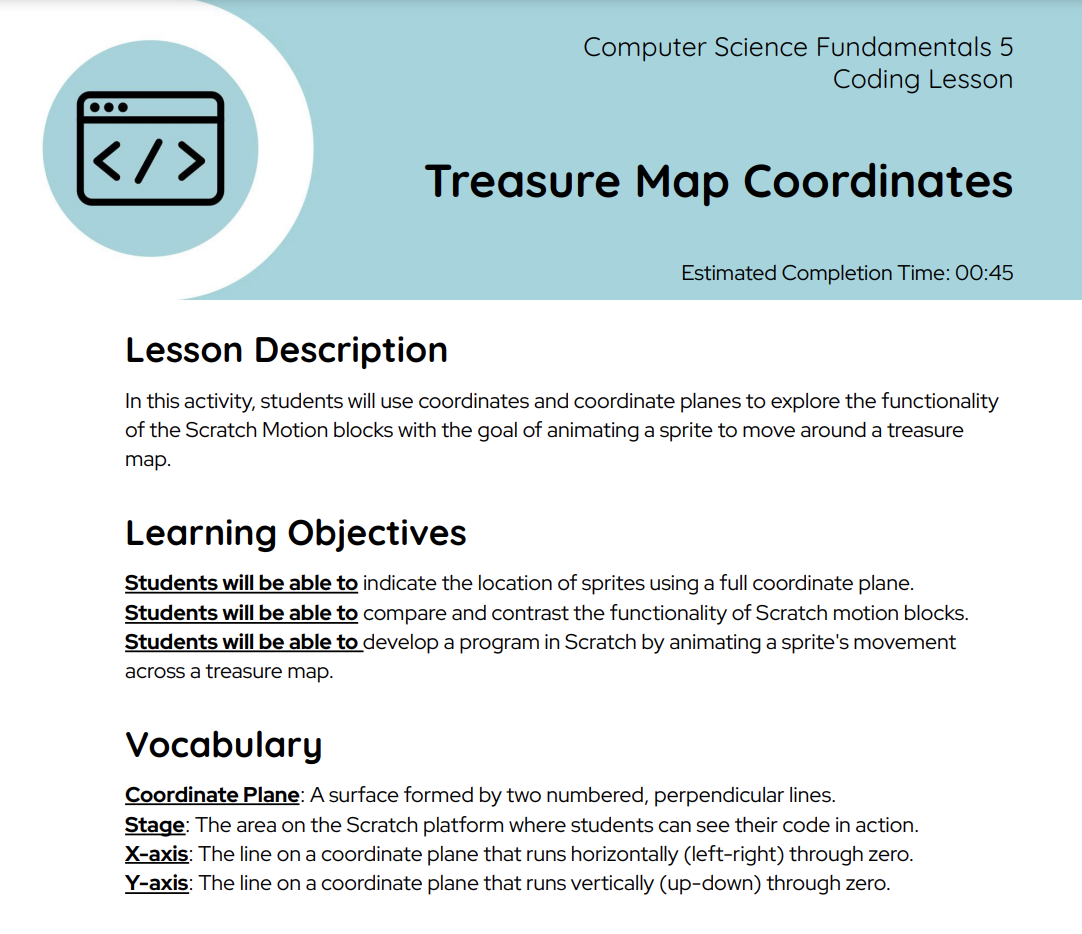Arkansas Innovation in Computer Science Grant
Since the ADE is offering up to $25,000 in grant dollars, teaching tech literacy might be top of mind. Curriculum from Ellipsis Education is eligible for the Arkansas Innovation in Computer Science Grant. Start a Free Trial to explore sample lessons from each of our courses and see an example syllabus, pacing guide, and standards map.
Ellipsis Education
Build teacher confidence and capacity with computer science curriculum from Ellipsis Education. Our K-12 courses have everything you need to get students going: detailed lesson plans (beyond just coding), pacing guides, standards maps, and ongoing support. That way, you can focus on what you do best – teaching.
Free Computer Lessons

In this activity, students will use coordinates and coordinate planes to explore the functionality of the Scratch Motion blocks with the goal of animating a sprite to move around a treasure map.
This lesson is built for grades 3 – 5 and introduces coding for kids: Scratch, a block based coding language.
The lesson PDF includes links to the appropriate materials and resources, a detailed procedure, activity tips, and a bonus challenge activity.
Arkansas Computer Science Standards
In 2021, Arkansas implemented a new set of computer science requirements. These standards are organized by grade band: K-4, 5-8, and 9-12. Each grade band has 5 main strands, with sub-categories indicating the content clusters. While the content clusters vary by grade band, the main strands are consistent for all grades. The main strands are as follows:
-
Computational Thinking and Problem Solving
-
Data, Information, and Security
-
Algorithms and Programs
-
Computers and Communications
-
Professionalism and Impacts of Computing
In addition to the general computer science standards, there is a coding block for 7th and 8th grade that also uses the same core strands. The content clusters start in K-4, and then more are added for every grade brand. Find the Arkansas Department of Education standards for each grade band here.
The Division of Elementary and Secondary Education website has a Computer Science Teacher and Curriculum Resources page that lists curriculum resources organized by grade band, as well as general resources and a separate page with professional development opportunities. For more free resources to support your computer science journey, Ellipsis Education provides free, downloadable content for your classroom. This page includes professional development webinars, STEM careers interviews, free lessons, and case studies.
What Is Computer Science Education
The importance of computer science in education is clear as technology continues to advance. According to the Bureau of Labor Statistics, employment in computer and information technology occupations is projected to grow 11% from 2019 to 2029. Arizona is a center for innovation and scientific progress in STEM, home to global companies from airlines (United) to pharmaceuticals (Johnson & Johnson). Given this, shouldn’t we equip our students with these skills starting at a young age?
Currently, computer science standards span from K-12; computer science education begins with the Arizona state standards kindergarten and goes all the way until AP Computer Science in high school. Most of these courses consist of a coding component, where students learn programming skills. The basic building blocks of coding such as loops, functions, and conditionals can be taught in elementary school and applied to more complex languages as students progress in their K-12 journey. As students attempt more advanced projects, such as developing websites, programs, and games, they are motivated to connect with their world and empowered to expand their skills.
Computer science education, however, is not only about coding. K 12 computer science also focuses on developing 21st century skills, such as the 4 C’s (communication, collaboration, computational thinking, and creativity). A strong foundation in these computer science skills will serve them well for years to come, regardless of the path they decide to pursue. The Arizona computer science standards are designed to encourage multidisciplinary learning. For example, standards for technology and computer science can be integrated into other core subject areas, like Arizona math standards and AZ science standards.
Title I
If you are a Title I school in Arkansas, you may consider using your federal funds to purchase computer science curriculum.
What is Title I Funding?
Title I funds programming for low-income students. The money must go toward helping these students meet academic state standards. The amount of Title I funding distributed across the nation is available through the DOE website (most recently updated in 2017).
What Can Title I Funds Be Spent On?
Title I usage is based on the makeup of your student body. If 40% or more of your school’s students come from low-income families, Title I funds must be used on school-wide initiatives. These are known as Title I schools. If less than 40% of your school’s students come from low-income families, Title I funds must be used for programming that targets low-income students. It is important to note that Title I funds must go directly to low-income students, and the programs/materials cannot have been used in other classrooms first.
K 12 Computer Science Curriculum
Ellipsis Education provides full-year K-12 computer science curriculum that aligns with the Arkansas computer science standards. The curriculum offers grade level differentiated learning pathways, aligns with all state and national computer science standards, and is continually updated to reflect changes in computer science. Ellipsis Education courses are customized to districts’ unique instructional strategy for computer science integration. This can mean incorporating computer science into an existing class period, adding to a specials rotation, or introducing a stand alone class. Courses are delivered with instructional resources teachers need to feel confident teaching computer science in K-12.
Our computer science curriculum for K-2 empowers you to engage your students with courses that fuel their interest. Coding lessons use ScratchJr, an introductory block coding language, perfect for emergent and early readers. In grades 3-5, inspire your students with courses that spark their creativity. Coding lessons use Scratch, a block based coding language, ideal for the transitional and fluent reader.
Our computer science curriculum middle school (6-8) helps you motivate your students with courses that connect to their world. Coding lessons use line based languages JavaScript, HTML, CSS, and Java to explore programming options.
Our computer science high school curriculum (9-12) helps you empower your students with courses that expand their skills. Coding lessons use JavaScript, Java, Python, and Godot to develop websites, programs, and games.
Explore our full k-12 computer science education course offering on our courses page. If any of these course options interest you, schedule a 30 minute call with one of our curriculum experts. Find the curriculum that will support every teacher as they inspire every student.
Computer Science Careers
After being introduced to computer science curriculum in K-12, students may be inspired to continue their computer science education. On a professional level, companies are recruiting for computer science degree jobs in cloud computing, app development, and statistical analysis. On an individual level, computational thinking, problem solving, and relationship building are all deeply influenced by computer science. This understanding of computer science jobs leads to much broader applications. you don’t necessarily need a degree in computer science; anyone that uses technology to solve problems can be considered a computer scientist!
Introducing computer science in the K-12 experience opens doors for students to pursue a computer science degree in college. The top computer science colleges in Arizona, including Arizona State University, University of Advancing Technology, and University of Arizona offer concentrations in various areas of computer science, like computer information systems, information technology, computer software and applications, and computer systems networking. The reality is, though, students do not need to attend a university to pursue these computer science majors. Even non-STEM majors, like business, biology, and English use computer science skills to communicate ideas.
Likewise, computer science skills taught in K-12 can be applied directly to any career students pursue after high school. Computational thinking, problem solving, and teamwork can be applied in trades (like electrician, plumber, and HVAC) and other positions (like retail, restaurants, and reception).
Ellipsis Education spotlights the many forms of computer science careers in our My STEM Career series. In these interviews, hear from professionals, students, and teachers as they share how they built confidence in their computer science skills. Two particularly interesting interviews include Will Muto, a Product Technical Director at Industrial Light and Magic, who worked on Star Wars films, and Alia Enos, Software Developer II at 343 Industries, who works on the Halo video game series.
Free Computer Lessons

In this activity, students will use coordinates and coordinate planes to explore the functionality of the Scratch Motion blocks with the goal of animating a sprite to move around a treasure map.
This lesson is built for grades 3 – 5 and introduces coding for kids: Scratch, a block based coding language.
The lesson PDF includes links to the appropriate materials and resources, a detailed procedure, activity tips, and a bonus challenge activity.
